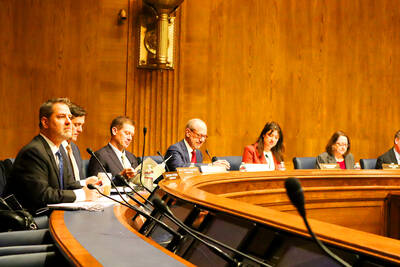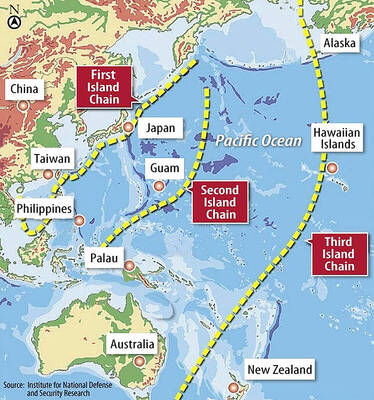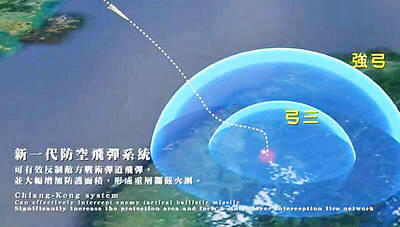US Federal Reserve Chairman Alan Greenspan yesterday urged China to ease tight controls on its exchange rate for the sake of its own financial health, but China's top central banker said the country's fragile financial system needs more time to prepare.
"I've said on numerous occasions I think it is to the advantage of China to allow a little more flexibility in the exchange rate," Greenspan told a conference of central bankers in Beijing, speaking via satellite video link from Washington.
"It is something that I am certain they will take on reasonably soon," he said during a panel with key central bank officials from China, Japan and Europe.
While Greenspan expects China to move "soon," China's central bank chief suggested there was more work to be done first.
"China needs to prepare -- first, to reform financial institutions to fit into the future environment of foreign exchange flexibility," said Zhou Xiaochuan (
The exchange rate "is an economic issue, not a political issue," Zhou said.
Beijing also worries that a sudden shift in the yuan could affect unemployment, economic growth and consumer confidence, Zhou said.
He didn't give any indication when the communist government might allow a freely traded yuan.
Currency traders expect Chinese authorities to introduce more flexibility to the yuan's exchange rate within the year, possibly by widening the band in which it is allowed to trade versus the US dollar. Should that happen, the yuan is widely expected to appreciate against the US dollar, lifting with it the yen and other Asian currencies against the dollar.
"Basically, China is ready," said Frank Gong, managing director at J.P. Morgan Chase and Co in Hong Kong.
But, China wants "to depoliticize the issue first, then it will move," Gong said, predicting a wider trading band within the next few months.
To maintain its currency controls, China has to buy large quantities of US dollars -- an arrangement that Greenspan said "cannot go on indefinitely."

LIMITS: While China increases military pressure on Taiwan and expands its use of cognitive warfare, it is unwilling to target tech supply chains, the report said US and Taiwan military officials have warned that the Chinese People’s Liberation Army (PLA) could implement a blockade within “a matter of hours” and need only “minimal conversion time” prior to an attack on Taiwan, a report released on Tuesday by the US Senate’s China Economic and Security Review Commission said. “While there is no indication that China is planning an imminent attack, the United States and its allies and partners can no longer assume that a Taiwan contingency is a distant possibility for which they would have ample time to prepare,” it said. The commission made the comments in its annual

DETERMINATION: Beijing’s actions toward Tokyo have drawn international attention, but would likely bolster regional coordination and defense networks, the report said Japanese Prime Minister Sanae Takaichi’s administration is likely to prioritize security reforms and deterrence in the face of recent “hybrid” threats from China, the National Security Bureau (NSB) said. The bureau made the assessment in a written report to the Legislative Yuan ahead of an oral report and questions-and-answers session at the legislature’s Foreign Affairs and National Defense Committee tomorrow. The key points of Japan’s security reforms would be to reinforce security cooperation with the US, including enhancing defense deployment in the first island chain, pushing forward the integrated command and operations of the Japan Self-Defense Forces and US Forces Japan, as

INTERCEPTION: The 30km test ceiling shows that the CSIST is capable of producing missiles that could stop inbound missiles as they re-enter the atmosphere Recent missile tests by the Chungshan Institute of Science and Technology (CSIST) show that Taiwan’s missiles are capable of intercepting ballistic missiles as they re-enter the atmosphere and pose a significant deterrent to Chinese missile threats, former Hsiung Feng III missile development project chief engineer Chang Cheng (張誠) said yesterday. The military-affiliated institute has been conducting missile tests, believed to be related to Project Chiang Kung (強弓) at Pingtung County’s Jiupeng Military Base, with many tests deviating from past practices of setting restriction zones at “unlimited” and instead clearly stating a 30.48km range, Chang said. “Unlimited” restrictions zones for missile tests is

PUBLIC SAFETY: The nationwide distribution campaign aims to enhance society’s overall understanding of threats and bolster defense awareness, an official said The latest edition of the National Public Safety Guide is being mailed to all citizens starting today to foster public awareness of self-defense in the event of war or natural disasters, the Ministry of National Defense said yesterday. “The guides will be disseminated to the public to enhance society’s overall understanding of threats and bolster defense awareness, demonstrating the government’s emphasis on people’s safety and its determination to pursue self-defense,” All-out Defense Mobilization Agency Director Shen Wei-chih (沈威志) said at the ministry’s news conference. The nationwide distribution campaign was planned according to President Lai William’s (賴清德) Sept. 20 directive, he said, adding